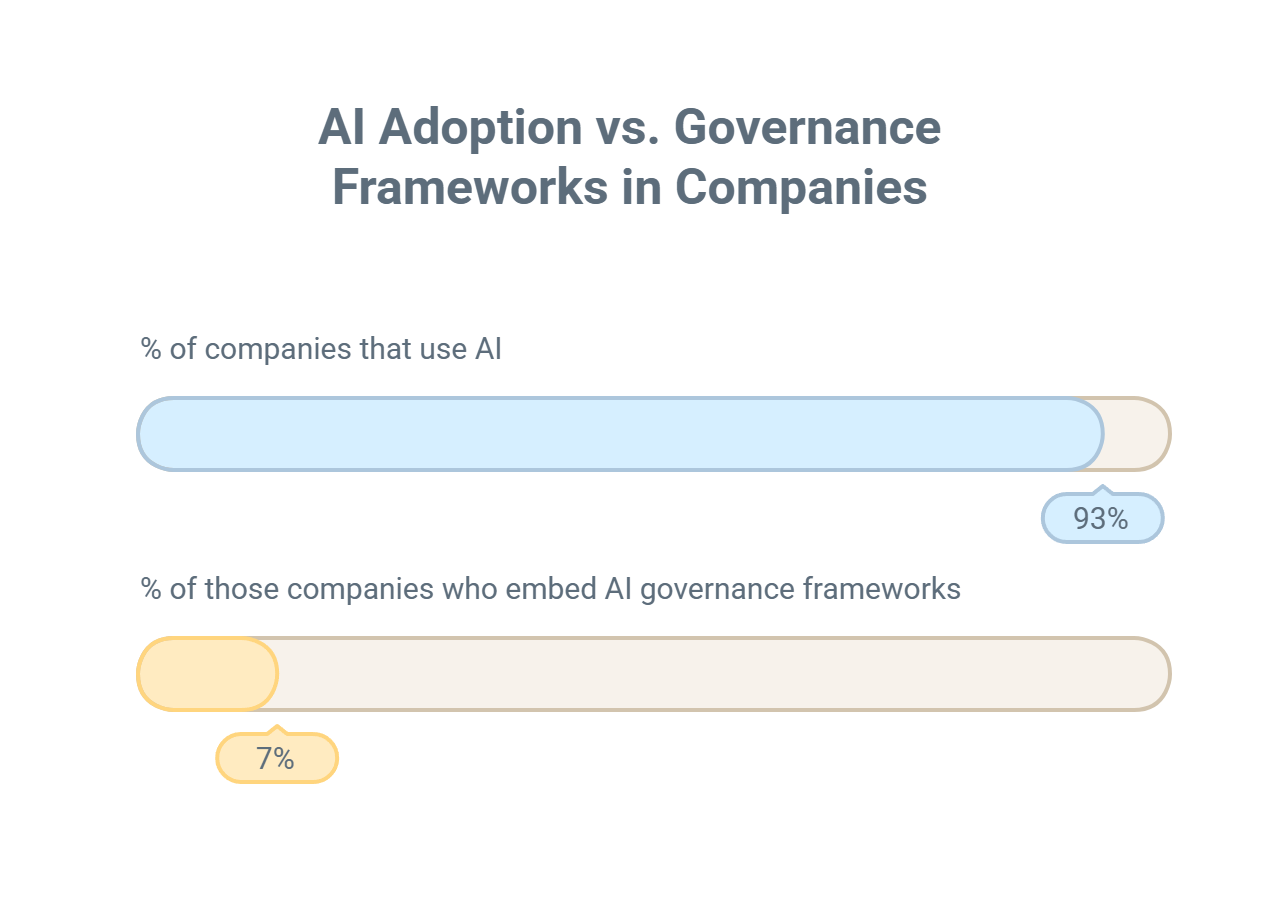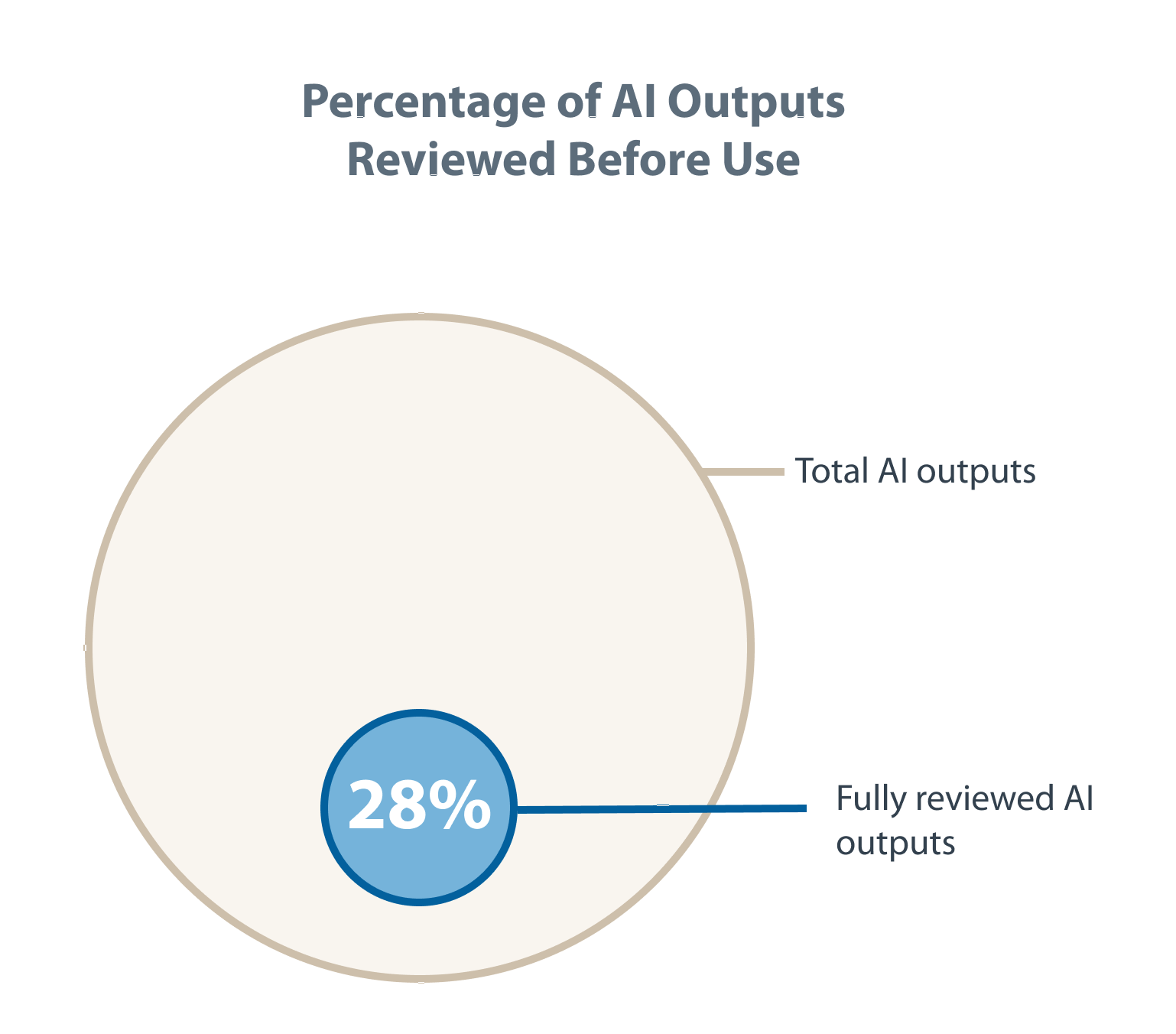Making the Business Case for ISO/IEC 42001 Certification
August 5, 2025
Turning AI Governance into a Business Priority
AI adoption is scaling exponentially, with 78% of organizations reporting the use of AI in 2024, up from 55% the year before. But governance is falling behind: a recent report shows that while 93% of companies use AI, only 7% have fully embedded governance frameworks. This gap exposes organizations to risks -- from compliance failures to reputational damage.
This white paper is designed to address these issues by helping professionals in risk, compliance, and AI governance roles build and present a compelling business case for ISO/IEC 42001 certification.

Why Certification Matters
Awareness of AI governance is growing: 77% of organizations are actively implementing governance programs, and governance is a top-5 strategic priority for 47% of respondents, including 89% of those already using AI. But only 12% of businesses with frameworks in place have dedicated AI governance architecture. The rest try to force AI into existing processes.
ISO/IEC 42001 delivers formal structure and global recognition that allows businesses to move from scattered AI oversight to a comprehensive, certifiable AI governance system. It supports resilient innovation and prepares businesses for emerging AI regulations like the EU AI Act, Canada’s AIDA, and evolving US requirements.
Core Business Drivers for Certification
Here’s how you can present the strategic value of ISO/IEC 42001 in conversations with leadership:
1. Demonstrating Leadership & Trust in the Marketplace
ISO/IEC 42001 is the first-ever certifiable AI governance standard. Early certification positions your organization as a trusted AI leader in industries under the watchful eye of both regulators and the public. It also enhances Environmental, Social and Governance (ESG) narratives around transparency and ethical AI. These are highly valuable in RFPs and enterprise vendor assessments.
2. Regulatory Readiness for Global AI Rules
Stanford’s 2025 AI Index reports a 21% increase in AI-related legislation across 75 countries in from 2023-2024 alone. Since 2016, the number of AI related legislations worldwide has increased by nine times. Certification aligns with regulatory principles ahead of enforcement, reducing retroactive compliance costs.
3. Simplifying Compliance and Lowering Overhead
Integrating ISO 42001 into existing frameworks such as ISO 27001, ISO 27701, SOC 2, and NIST AI RMF enables cross-framework control reuse. This reduces duplicated effort, simplifies the audit process, and enhances operational efficiency. These points will be invaluable for CFOs and audit teams.
4. Enhancing Risk Management and Incident Response
Without formal governance, AI systems can carry hidden dangers. Only around 28% of AI outputs are fully reviewed for bias or interpretability before use, which can lead to a myriad of issues later down the line. ISO/IEC 42001 ensures documented, audited human oversight and risk controls, which improves resilience and accountability.

5. Unlocking Scalable Innovation
CEO oversight of AI is correlated with earnings growth, especially when workflows are redesigned to embed AI appropriately. Certification offers consistent governance and clarity, reducing friction and accelerating responsible AI scaling.
Overcoming Common Executive Objections
Include relevant data or case references to reinforce each reframing.
| Objection | How to Reframe |
|---|---|
| “It’s too early to invest in a new certification.” | Strong governance becomes harder to retrofit. Early certification reduces future cost and embeds AI compliance from the start |
| “We already have informal AI policies.” | Certification validates and formalizes governance. It proves controls are implemented, auditable, and repeatable. |
| “This adds red tape for AI teams.” | On the contrary—structured governance reduces friction with Legal, Security, and Compliance, speeding up approvals and avoiding last-minute delays. |
How to Structure the Business Case
Here’s a fleshed-out template for building a leadership-grade business case:
1. Strategic Fit
Align certification with corporate goals: trust, regulatory readiness, ESG credibility, market differentiation.
2. Risk Landscape
Quantify the gap: governance rate vs. AI adoption. Describe potential threats such as bias fines, fraud, and reputational incidents.
3. Efficiency Through Integration
Map how ISO/IEC 42001 reuses existing controls and avoids constructing governance from scratch. Estimate time saved in audits or control maintenance.
4. Market and Regulation Trends
Highlight AI governance momentum: 55% of organizations now have AI governance boards, and board-level oversight is growing.
5. Investment vs. ROI
Estimate costs for gap assessment, training, controls, and certification. Model savings from reduced audit effort, avoidance of legal risk, and brand trust (e.g. fewer third-party risk objections).
6. Timeline and Phases
- Suggest a phased rollout:
- Readiness assessment
- Launch a pilot test in one area first
- Integration
- Certification
Provide suggested duration and milestones.
Sample Executive Pitch Language
Use this pre‑written text in an internal memo, presentation, or executive summary slide:
“Pursuing ISO/IEC 42001 certification positions us as a leader in responsible AI by aligning with the world’s first certifiable standard for AI governance. It provides clear, auditable assurance to regulators, customers, and partners that our AI systems are safe, ethical, and well-governed. By leveraging our existing controls in privacy, security, and risk, we can integrate this framework with minimal disruption—and move quickly toward regulatory readiness. We should launch a readiness assessment this quarter to secure an early-mover advantage and build enterprise-wide AI trust.”
Supporting Talking Points with References (2025):
- “Only 7% of organizations using AI have embedded full governance. This is a critical gap we can close.”
- “78% of organizations use AI—44% lack structured oversight. This can lead to costly vulnerabilities.”
- “ISO/IEC 42001 aligns with EU AI Act, Canada’s AIDA, and US regulation trends. Strong governance would enable compliance ahead of enforcement cycles.”
Conclusion
ISO/IEC 42001 certification can be both compliance effort and strategic asset. It embeds governance into your AI journey, transforming AI deployment from a risky experiment into disciplined, trust-based innovation that aligns with global regulatory trends and stakeholder expectations.
For AI and compliance leaders, persuading executive decision-makers with data, structure, and market context will position ISO/IEC 42001 as a foundational enabler of business resilience and differentiation.
Liked this article? Download it, free
Want a sharable version of this content to read offline or share with your team? Download this article here as a PDF white paper--completely free.
Share this article





